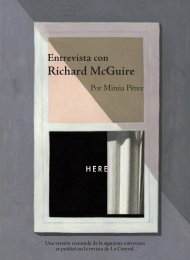Fabra Internacional
La_lucha_contra_la_inefabilidad_cuco2
La_lucha_contra_la_inefabilidad_cuco2
Create successful ePaper yourself
Turn your PDF publications into a flip-book with our unique Google optimized e-Paper software.
Raquel Crisóstomo Gálvez<br />
ries themselves were not really mine or rather that I had no claim to them because my memories<br />
lacked the pain that was theirs. If I had not suffered, then I had no authentic memories. It<br />
has taken me many years to recognize that not only are the memories mine but that some of<br />
the pain is mine as well. 11<br />
Al fin y al cabo Spiegelman es un creador experiencial, que materializa los traumas en<br />
sus obras:<br />
The rubble of the World Trade Center was a historical “gift” that fell into his lap —almost<br />
literally, since he lives in Lower Manhattan— a trauma finally his own, in wich historical<br />
catastrophe is both personal and family history, as it was in Maus. 12<br />
Como vemos, ante del horror vivido, se intuye un camino: el arte, que se convierte en<br />
mágico, es un espejo transfigurador que salva, cuyo resultado es lo sublime; y la escritura<br />
se convierte en algo catárquico:<br />
The act of telling, too, is complicated in postmodernist fashion both by Art/Artie’s freqüent<br />
portrayal of the act (and difficulty) of creating the project of Maus (e.g. he draws himself at<br />
his drafting board, surrounded by mouse corpses that simultaneously represent the carnage of<br />
the Holocaust and his own guilty role as the maker and destroyer of the characters in his own<br />
work). 13<br />
El profesor de literatura comparada judía de la Hebrew University of Jerusalem, Sidra<br />
DeKoven Ezrahí, se refiere a la escritura después de la Shoah: “Precisely when it<br />
is most confined to the unimaginable facts of violence and horror, the creative literature<br />
that has developed is the least consistent with traditional moral and artistic<br />
conventions.” 14<br />
La gestión de la memoria ajena.<br />
Para Art Spiegelman, la creación de Maus le ayuda a ser consciente del horror vivido por<br />
sus padres, que a pesar de ser ajeno, se convierte en una experiencia propia por el hecho<br />
de formar parte de la siguiente generación a los supervivientes directos y por todas las<br />
repercusiones que esto ha comportado en su vida.<br />
La historia que nos ocupa ilustra la problemática de la autobiografía, un género con un<br />
papel clave en el mantenimiento de la memoria. El historiador Wilhelm Dilthey (1833-<br />
1911) remarcaba la importancia del género autobiográfico para entender la historia; y<br />
el filósofo Georges Gusdorf (1912-2000) defendía que el proceso de escritura era muy<br />
importante: la autobiografía reune pasado y presente, y comporta sobre todo el esfuerzo<br />
11<br />
Fass, P Op. cit., p. 3.<br />
12<br />
Orban, K. “Trauma and visualiy: Art Spiegelman’s Maus and In the Shadow of No Towers” Representations,<br />
2007.<br />
13<br />
Geis, D. (ed.). Considering Maus, Approaches to Art Spiegelman’s “Survivor’s Tale” of the Holocaust, Tuscaloosa,<br />
University of Alabama Press, 2003, p. 2.<br />
14<br />
Geis, D. (ed.). Op. cit., p. 3.<br />
Cuco, Cuadernos de cómic número 2. Abril de 2014<br />
CuCoEstudio<br />
83



